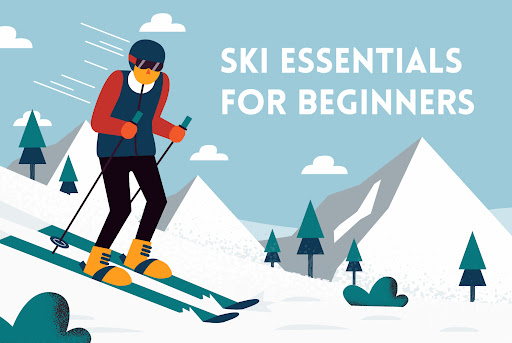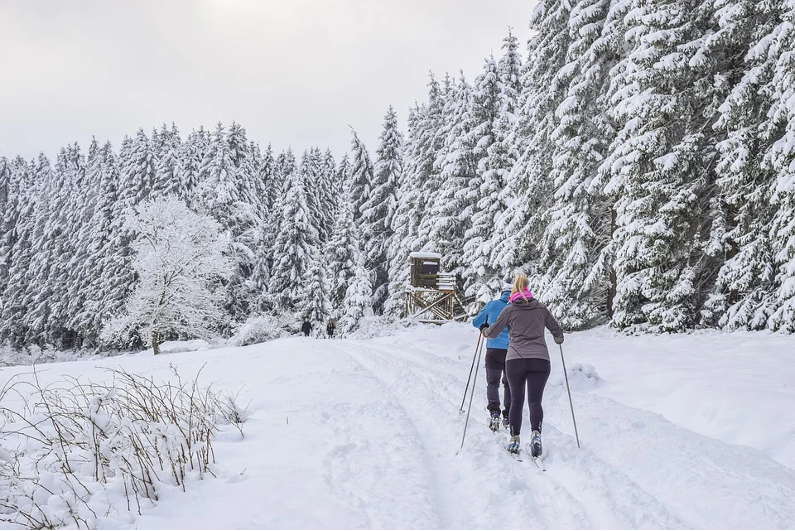If you enjoy watching skiing but have never been on skis, it’s time to fix that. Let’s talk about the health benefits and possible risks of the sport.
Benefits of skiing for beginners
Skiing is a trendy sport. Everyone involved in it has different goals: one seeks the title of champion, another wants to develop endurance and strength, a third wants to lose excess weight, and a fourth – wants to strengthen willpower. And everyone can achieve what they aspire to—the main thing – regular and persistent training.
You can even play casino online on the theme of skiing because such entertainment is in great demand today and has many variations.
History of skiing
The emergence of skiing is naturally related to the conditions of human habitation. People invented the first prototypes of modern skis where there was snow and frost. Originally they were foot skis. The oldest specimen was made about 4300 years ago.
Sliding skis appeared in the VI-VII centuries in Finland and Holland. They were used for hunting and household purposes. Monarchs used skis for entertainment, and skiing was necessarily taught to courtiers.
But skiing was born in Norway, where in 1733, ski training became mandatory for military personnel. The first competitions were held in 1767. They included all modern disciplines (according to the rules of the time): biathlon, slalom, race, and downhill.
Since 1877, sports societies and clubs for ski enthusiasts began to open: first in Finland and then in other countries. In addition, skiing competitions became part of folk festivals. And at the end of the 19th century, skiing became a sports discipline, competitions that took place across the globe.
Skiing was included in the Olympics from the first day of its history – France’s first Olympic Winter Games. Athletes competed in the 18, and 50-km cross-country skiing, ski jumping, and Nordic combined.
Benefits of skiing
Its impact on health and character occurs in three ways:
- Recreational. Walking, running, and ski jumping benefit the body, and intense exertion increases strength and endurance.
- Educational. Classes skiing develop willpower, discipline, self-control, and other important personal qualities.
- Applied. Skiing is used for human health, as well as in the workplace and everyday life.

Skiing and Health
Ski training has a comprehensive positive impact on the human body. On the one hand, this is due to the inclusion in the work of almost all muscle groups, and on the other hand – being in the fresh air. In addition, gentle loads make skiing accessible to people of all ages – from young children to seniors.
The main benefits of ski training include:
- Strengthening the immune system through prolonged exposure to the freezing air is similar to hardening.
- The heart and blood vessels activity at the expense of cardio-load during walking and running on skis.
- Getting rid of insomnia, and depression, normalization of the nervous system, and fighting stress.
- Ventilation of the lungs is accompanied by an increase in the volume of oxygen penetrating the blood.
- Getting rid of excess weight and strengthening the muscles.
Contraindications
Like any physical activity, skiing has its contraindications. For example, you should not engage in skiing if you have:
- Abnormalities in the heart, blood vessels, and respiratory system.
- Pregnancy.
- The tendency to colds.
- Diseases of the joints.
- Recent trauma and surgical interventions.
In addition, a not uncommon phenomenon when practicing skiing is injuries. They can be due to safety violations, poor-quality or illiterate equipment, riding on unsuitable roads, and frequent at the initial stages of training.
Disciplines
Skiing involves about 20 disciplines, many of which are included in the Olympics.
They can be grouped into five significant groups:
- Cross-country skiing. The most common, one might say, is the classic discipline. Races are held at various distances in the form of sprints (including team races), pursuit races, and relays.
- Downhill skiing. Downhill skiing refers to extreme discipline. It has a specific route for the designation of which special gates are installed. The length of the course is 3 km and more. Downhill skiing includes slalom – descent from a mountain slope equipped with obstacles. Its varieties are super-giant and giant slalom.
- Ski Jumping. It is a professional discipline that uses special skis that allow you to control the flight when leaving the ground. They are called wings skis. In ski jumping, you must fly beautifully for at least 100 meters and land without falling. The combination of racing and ski jumping was called Nordic combined.
- Snowboarding – performing exercises using one ski. It is subdivided into several disciplines: giant and parallel slalom, snowboard cross, and others.
- Freestyle. Translated as “free skiing” and includes a group of programs. For example, acrobatics involves performing tricks in the air after a ski jump. Mogul – descending a slope with lots of bumps. Ski-cross – overcoming a 1.2 km track full of obstacles and altitude changes.
How to take up skiing
Those who have decided to join the ranks of skiers should know the most essential starting points:
- Improperly chosen equipment and equipment entails the occurrence of injuries. It is especially true for skis – the leading equipment of athletes. They are selected, taking into account the height of the skier. It is also important to remember that there is a specific type of skis for each subspecies of skiing. Clothing for training should meet the two main requirements: not to limit the movement and not to let the heat pass.
- Before you start training, you should be examined for contraindications and get advice from a specialist.
- You should train on the principle of increasing loads, that is, start with the smallest. The first lessons are recommended to spend under the guidance of an experienced coach.
- For riding, you should choose only prepared tracks.
- For those who set the goal of professional sport and outstanding achievements, it is better to start training at special schools according to approved programs. You can begin training in popular slot games on the theme of skiing, and it will help you catch the right mood for training.
Does skiing help me lose weight?
Skiing is one of the best ways to lose weight and fight excess weight. Importantly, cross-country skiing can be called the most effective cardio for shaping the abdominal muscles and abs. This effect is achieved through the complex involvement of external and internal layers of the body’s musculature.
Skiing is a good form of fat-burning cardio. Scientific studies tell us that each hour of skiing burns about 500-1200 kilocalories – the final figure always depends on the technique used and the overall intensity of the workout. The terrain also directly affects the calories spent during the ski trip because going uphill is heavier.
Hazards of cross-country skiing
The critical danger of cross-country skiing is the risk of injury from a nasty fall. But this danger is obviously much lower than downhill skiing or snowboarding. Note also that skiing in the fresh snow in the woods requires some practice and the ability to avoid unexpected falls into holes.
Other hazards of skiing are dehydration and sunburn – because in the cold weather is often not thirsty, and the water itself cools pretty quickly, so athletes should have a thermos with warm tea. Among other things, it is recommended to apply a cream with SPF protection on the face in sunny weather.
Skiing to strengthen the immune system
As mentioned above, regular skiing trips strengthen the cardiovascular system, improve cardiac muscle function, normalize blood pressure and optimize metabolic processes. Taken together, these factors positively improve immunity and the body’s ability to resist colds.
The role is also played by the fact that physical activity at subzero temperatures forces a person to breathe more often, increasing the amount of oxygen used – this causes the body to produce more joy hormones and provokes the so-called “euphoria of the runner”. Not to mention that skiing in the woods gives a chance to breathe clean air.





